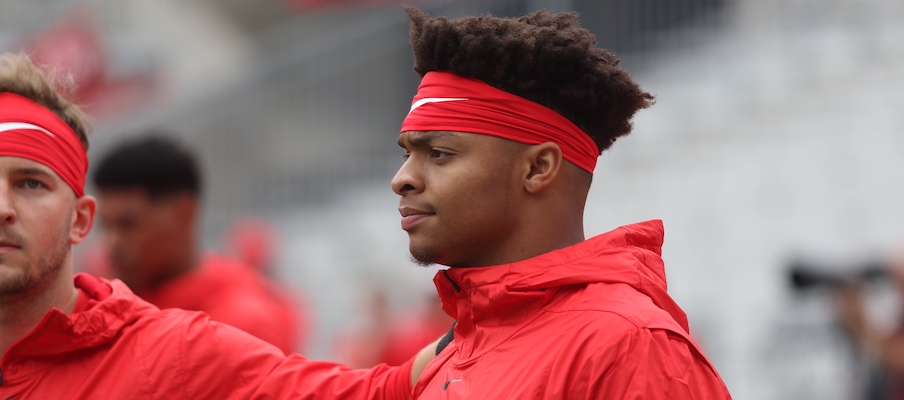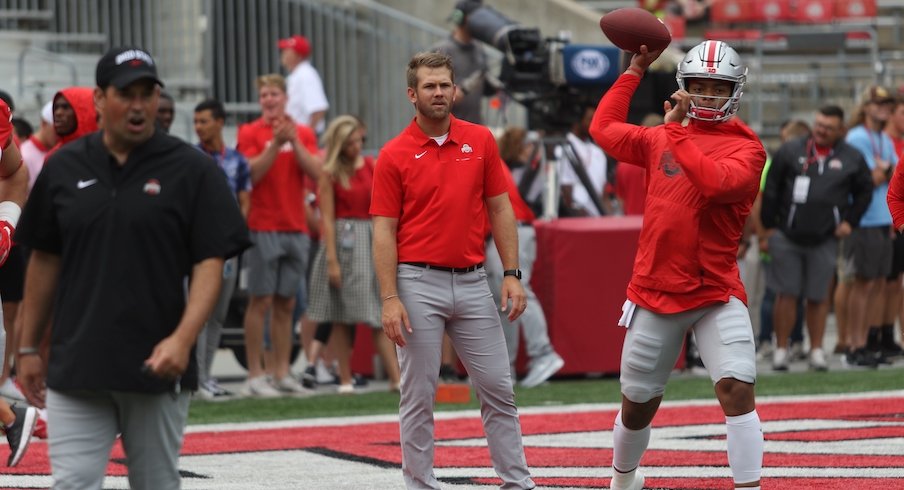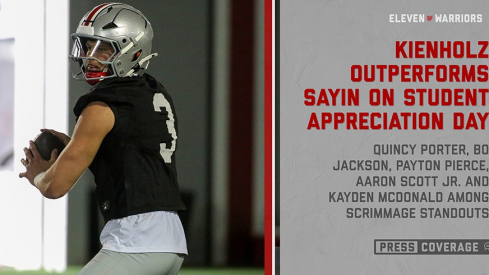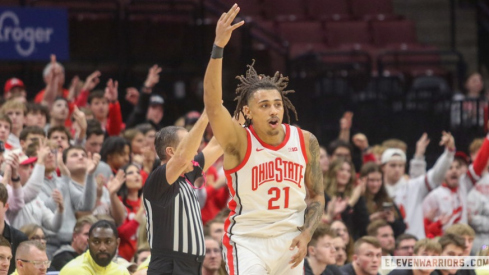Already with a 28-0 lead in the second quarter against Florida Atlantic on Saturday, Ohio State didn’t need to press.
Sure, the Buckeyes wanted to score, of course. But with a four-touchdown lead and 4:41 remaining until halftime, nobody had to force anything, possibly leading to a detrimental mistake. So on 3rd-and-8 from his team’s 41-yard line, Justin Fields played it smart.
Ryan Day called for a pass with a seven-man protection, and the Owls had just three players rushing. The defensive tackle, though, found an opening up the middle between left guard Jonah Jackson and left tackle Thayer Munford, which turned Fields around, sending him scrambling backward and to his left. As he repositioned himself, he reset his feet, seeming to continue scanning downfield. But as he got hit, rather than attempting to complete a pass into a tight window, Fields heaved the ball out of bounds, bouncing it into the concrete wall where the stands began.
That, Ryan Day said on Monday, was the quarterback’s best play of his first start.
“It was something you maybe not even noticed,” Day said.
Not the 51-yard rushing touchdown on the first drive. Not the 25-yard touchdown pass to Jeremy Ruckert, the 32-yard touchdown pass to Binjimen Victor or the 29-yard touchdown pass to Chris Olave. Not any of the 18 passes Fields completed in the 45-21 victory.
Day singled out the thrown-away pass to end a drive on a three-and-out because to him, the decision not to attempt anything foolish signaled a development in his quarterback’s thinking.
“That was my favorite play of the day because he's understanding what it means,” Day said. “It's very hard for somebody who hasn't played a lot of football to understand that that play right there is just as important as the play you make because if you try to throw the ball in the traffic and turn the ball over, it's a disaster. We have a good defense, punt, put them inside the 10-yard line and we'll get the ball back soon enough. We'll have another shot.”
Prior to Saturday, Fields had never started a game. But that didn’t quell the boatloads of hype that followed him from Georgia to Ohio State eight months ago. It stemmed from him being the No. 2 overall recruit in the 2018 class, just behind Clemson’s Trevor Lawrence. His Elite 11 MVP performance and purported 40-yard dash time of 4.4 seconds only heightened expectations.
“He played well in terms of game management. Didn't try to do stuff that wasn't there.”– Ryan Day on Justin Fields' starting debut
Sometimes, given his talent level and the recent success of inexperienced quarterbacks, his lack of playing time in college goes forgotten. This is still a young, developing quarterback who played sparingly as a freshman before transferring from Georgia to Ohio State eight months ago.
Day certainly knew about Fields’ skill set long before he ever landed him as a transfer, which might partly explain why he’s so eager to get him to make correct decisions.
If everything goes right, Fields has the natural ability to become a frontrunner for the Heisman Trophy by the end of his Ohio State career. So, how might Fields not reach his ceiling? If he never pairs his strong arm and top-flight speed with passing touch and decision-making skills. Those, not coincidentally, have been areas of focus for Fields. So he felt no surprise when Day said he liked the incomplete pass aimed at the stands better than anything else he did on Saturday.
“He always tells me that in practice because he really emphasizes just playing smart and taking care of the ball,” Fields said on Tuesday. “So I'll have a crazy touchdown in practice and then he'll tell me after practice is done, 'My favorite play is when you threw the ball away.' That's not the first to hear that from him. He just likes when I play smart and I just make smart decisions.”
The focus on avoiding potentially costly mistakes extends all the way back to when Day began coaching Fields in the spring.
“You just have to know the situation, really, and know what's best for the team,” Fields said. “I think he's really just ingrained that in my brain just taking care of the ball and just making the smartest decisions because it's nothing wrong sometimes 3rd-and-long just throwing the ball away and just putting the ball away. There's nothing wrong with that.”

Fields didn’t have any spectacular plays that could have happened had he chosen to take a risk and squeeze passes into tight coverage. All four of his touchdown passes went to wide-open receivers, and his 51-yard touchdown scamper early in the first quarter happened with an open lane to the end zone.
That, though, might have been part of a strategy. Day doesn’t need him to try to do too much and end up turning the ball over; he wants to build good habits in his quarterback. On Saturday, Fields neither threw an interception nor fumbled the ball. He didn’t have anything close to a turnover.
“He played well in terms of game management,” Day said. “Didn't try to do stuff that wasn't there.”
The need for intelligent decision-making extends to Fields’ knowledge of when to scramble and when to take hits. There, too, he remains in the learning phase.
Fields said when he walked into the training room on Sunday and was asked, “What hurts?” he responded by saying, “Everything.” With his top-end speed, Fields didn’t often hesitate to tuck the ball and take off on the ground in high school, knowing he likely had the speed advantage on the defensive players. Under Day, he has had to learn when to remain in the pocket to deliver passes and when to escape and take off on the ground.
“I think from day one of spring practice, where Justin is right now, is considerably different and we have to keep building on that,” Day said. “But he stood in there and took some shots. The one he threw to Chris Olave, he took it on the chin and I thought he threw one heck of a ball right down the field. The touchdown to Ruckert, he got hit right in the mouth. He stood in there. That's playing in the Big Ten and that's what it's going to be like moving forward.”
As Day says, Fields is still learning, and that applies to multiple facets of his game. He doesn’t want Fields to think he needs to do anything otherworldly in the first couple weeks of his first season as a starting quarterback. Day just wants to see him make the right reads and smart throws.
If the approach Day’s employing works, those breathtaking moments will come as Fields continues to learn how to evaluate risk and avoid unnecessary mistakes.


